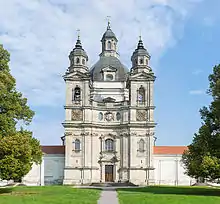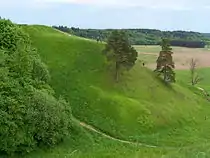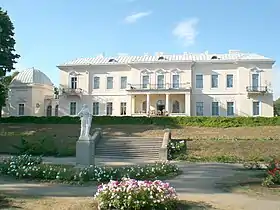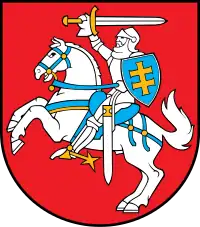Tourism in Lithuania
Lithuania attracts many visitors from neighbouring countries and all over the world. In 2018, 1,7 million foreign visitors arrived to Lithuania for business,family and leisure.[1] Historical legacy of the Grand Duchy of Lithuania, rich history, architecture, pristine nature, seaside and SPA resorts are the main attraction points of Lithuania. Domestic tourism is also highly popular - in 2018 it grew by 12% percent. Lithuanians also prefer to spend their vacations in Lithuania - 70 percent.[2]
.jpg.webp)

Overview
Lithuania experiences a constant increase of foreign visitors. In 2017, the accommodation establishments of Lithuania received 3.25 million tourists, which is by 6.2 per cent more than in 2016.[3] Lithuania attracts foreign visitors mostly from Germany, Poland, Russia, Latvia, Belarus, the United Kingdom, Estonia and Finland.
In 2017 hotels received 2.2 million tourists, or by 7 per cent more than in 2016. Number of Lithuanian tourists grew by 12.8 per cent, foreigners – by 3.3 per cent. The hotel room occupancy rate stood at 54.3 per cent (in 2016, 51.7 per cent), the hotel bed occupancy rate – at 41.4 per cent (in 2016, 39.7 per cent).[3]

Agrotourism has also gained extreme popularity in the country among the locals as well as foreigners. Ecotourism is actively promoted by the government and national parks – Lithuania has built a successful ecotourism industry, and is also been acknowledged as one of the world's most ethical destinations. Hot air ballooning is very popular in Lithuania, especially in Vilnius and Trakai. Theme routes through historical and nature sites are popular among domestic and international tourists. Nemunas Delta Regional Park and Žuvintas biosphere reserve are known for birdwatching.[4]
Tourism information centres operating in all majors cities and smaller towns, national parks and other places, attractive for domestic or international tourism.[5]
If the nature of the tour is that the guide is "interpreting the cultural and natural heritage of an area", Lithuania requires the guide have a guiding license. This definition follows the European standard for tour guiding (CEN). Licensed Tourist Guides are the only professionals permitted to conduct tours in all sites and museums within a city. Licensed guides are required in those areas where the local authorities state that one of them is mandatory.[6] There is a Guides Database to find a guide in your language as well.[7]
Arrivals by country
Most visitors arriving to Lithuania on short term basis in are from the following countries of nationality:[8][9]
| Rank | Country | 2015 | 2016 |
|---|---|---|---|
| 1 | Germany | 170,100 | 174,800 |
| 2 | Belarus | 163,500 | 171,900 |
| 3 | Russia | 149,700 | 150,600 |
| 4 | Poland | 127,200 | 148,400 |
| 5 | Latvia | 116,600 | 134,500 |
| 6 | Ukraine | 59,500 | 84,000 |
| 7 | Estonia | 52,600 | 58,300 |
| 8 | United Kingdom | 54,100 | 58,200 |
| 9 | Italy | 40,600 | 39,900 |
| 10 | Norway | 42,400 | 39,800 |
| Total foreign | 1,141,800 | 1,258,100 |
Major cities

- Vilnius – capital of Lithuania, in the past - capital of the Grand Duchy of Lithuania, first mentioned in Letters of Gediminas in 1323. Vilnius is full of cultural events – new operas, classical music, theatre and music festivals.[10]
- Kaunas – temporary interbellum capital of Lithuania with prominent functionalism architecture, art and history museums, largest city Oak Park in Europe.
- Klaipėda – sea port with an attractive old town, Lithuanian Sea Museum[11] and Dolphinarium.[12]
- Panevėžys – capital of Aukštaitija
- Šiauliai – famous for nearby Hill of Crosses
- Kėdainiai – city in central Lithuania with prominent Renaissance architecture monuments
National parks

Protected areas established for the preservation of natural and cultural features.
UNESCO World Heritage Sites
- Kernavė – ancient capital of Lithuania, a complex of historical hillforts and an archeological site, called "Troy of Lithuania"
- Curonian Spit – the resort and nature reserve.
- Vilnius Old Town – the old capital of the Grand Duchy of Lithuania, largest baroque city in Northern Europe, is among the largest historical centres in Europe.
Cultural and Cognitive Routes

In 2019 Cultural Route of Lithuanian composer Mikalojus Konstantinas Čiurlionis was opened which leads through the places in Varėna, Druskininkai, Kaunas, Vilnius, Plungė, Rietavas, Palanga where composer has lived.[13]
Cognitive or sightseeing routes (Pažintinis takas) are highly popular among domestic tourists. Usually they lead through unique places in nature, where the visitor can enjoy the nature and local history while walking some predefined path.
Resorts

Seaside resorts
- Palanga – the summer capital of Lithuania with sandy beaches
- Nida – a world heritage site with unique nature
- Juodkrantė – a resort in Neringa
Spa towns
- Birštonas – a balneological resort and a spa town, surrounded by pine forests.
- Druskininkai – a developed spa town with the largest water park in the Eastern Europe, the Snow Arena – one of the biggest indoor skiing slopes in Europe. The Water Park and the Snow Arena connected with the cable car.[14]
- Likėnai - a resort with mineral springs.
Pilgrimage sites

Lithuania has many holy sites, especially in Samogitia, which are worth a visit.
Major pilgrimage sites:
Military heritage
The country has some military sites left and may be very interesting place as a place of militarism heritage tourism. It might be interesting for anyone who is interested in history of the warfare or the Cold War.
Major militarism heritage sites in Lithuania:
- Kaunas Fortress, a massive system of forts built around Kaunas during the Russian Empire rule in the 19th century;
- Former Soviet Nuclear launch site near Žemaičių Kalvarija in Samogitia.[15]
Bicycle tourism

Bicycle tourism is growing, especially in Lithuanian Seaside Cycle Route. EuroVelo routes EV10, EV11, EV13 go through Lithuania. Total length of bicycle tracks amounts to 3769 km (of which 1988 km is asphalt pavement).[16] Most known bicycle routes are: Nemunas River Cycle Route, Suvalkija Cycle Circuit, Lithuanian Seaside Cycle Route. Most of the Tourism information centres and national parks have their local thematic bicycle route plans.
Museums
.jpg.webp)
Museums include:
- Lithuanian Museum of Ethnocosmology
- Palanga Amber Museum
- Vilnius Amber Museum-Gallery[17]
- Palace of the Grand Dukes of Lithuania
- Church Heritage Museum[18]
- Lithuanian Museum of Ancient Beekeeping
- National Gallery of Art[19]
- M. K. Čiurlionis National Art Museum
- Vytautas the Great War Museum
- National Museum of Lithuania
- Vilnius Castle Complex
- Vilnius Picture Gallery [20]
- Vilnius Toys' Museum [21]
- Museum of Occupations and Freedom Fights
- Lithuanian Aviation Museum
- MO Museum[22] - Museum of modern and contemporary Lithuanian art
- Tartle [23] - Museum of Lithuanian art heritage and artefacts.
- Klaipėda Clock and Watch Museum [24]
- Šiauliai Photography Museum [25]
- Akmenė Akemenė fossil museum [26]
Gallery
- Tourism in Lithuania gallery
 Gate of Dawn, Vilnius
Gate of Dawn, Vilnius_-_cathedral.jpg.webp)
.jpg.webp)
 House of Perkūnas, Kaunas
House of Perkūnas, Kaunas Water park at Druskininkai
Water park at Druskininkai
 Old houses in Klaipėda
Old houses in Klaipėda A street in Kėdainiai
A street in Kėdainiai



See also
- Castles in Lithuania
- Žemaitukas
- List of landmarks in Lithuania
- List of museums in Lithuania
- List of national parks of Lithuania
- List of regional parks of Lithuania
- Lithuania – Real is Beautiful – The Official Travel Guide by the State Department of Tourism
References
- "2018 for tourism: number of tourists exceeded forecasts".
- "Tyrimas: 70% lietuvių ilgąsias atostogas leidžia Lietuvoje, 27% nuomojasi būstą iš privačių asmenų". www.vz.lt. Retrieved 17 December 2018.
- "Tourism in Lithuania. 2017" (PDF). Statistics Lithuania. p. 6. Retrieved 24 November 2018.
- "Fatbirder. Lithuania". fatbirder.com. Retrieved 5 May 2018.
- "TOURISM INFORMATION CENTRES". lithuania.travel. Retrieved 25 May 2018.
- "Visit Lithuania". visitlithuania.net. Retrieved 2 June 2018.
- "Lithuanian Guides Dtabase". guides.lt. Retrieved 5 May 2018.
- "Number of guests and overnights in Lithuanian accommodation establishments. '000. All markets. 2014–2015".
- "Number of guests and overnights in Lithuanian accommodation establishments. '000. All markets. 2015–2016".
- Vilnius Events
- "Lithuanian Sea Museum". muziejus.lt. Retrieved 2 June 2018.
- "Lithuanian Sea Museum and Dolphinarium". muziejus.lt. Retrieved 2 June 2018.
- "Čiurlionio kelias". ciurlioniokelias.lt (in Lithuanian). Retrieved 24 May 2019.
- "Druskininkai Cable Car". lynukelias.lt. Retrieved 2 June 2018.
- Žemaitijos nacionalinio parko teritorijoje veikiantys muziejai Archived 8 May 2007 at the Wayback Machine
- Widawski, Krzysztof; Wyrzykowski, Jerzy (24 January 2017). The Geography of Tourism of Central and Eastern European Countries. books.google.lt. ISBN 9783319422053. Retrieved 5 May 2018.
- "Amber Museum-Gallery". ambergallery.lt. Retrieved 2 June 2018.
- "Church Heritage Museum". bpmuziejus.lt. Retrieved 2 June 2018.
- "National Gallery of Art". ndg.lt. Retrieved 2 June 2018.
- "Vilnius Picture Gallery". ldm.lt. Retrieved 1 November 2018.
- "Vilnius Toys' Museum". museu.ms. Retrieved 3 May 2019.
- "MO Museum". mo.lt. Retrieved 1 November 2018.
- "Tartle". tartle.lt. Retrieved 1 November 2018.
- "Klaipėda Clock and Watch Museum". ldm.lt. Retrieved 1 November 2018.
- "Šiauliai Photography Museum". ausrosmuziejus.lt. Retrieved 1 November 2018.
- "Akmenės muziejus". akmenesmuziejus.lt. Retrieved 24 March 2019.
External links
| Wikivoyage has a travel guide for Lithuania. |
- Lithuanian State Department of Tourism
 Media related to Tourism in Lithuania at Wikimedia Commons
Media related to Tourism in Lithuania at Wikimedia Commons- Lithuania Travel Guide
- Tourism in Lithuania
- Žemaitija National Park’s website
- Lithuanian Guides Database

